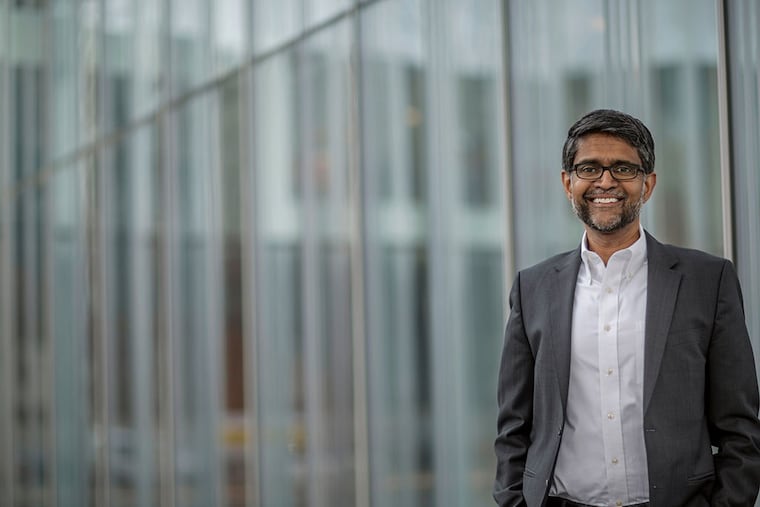Penn's new engineering dean is off to a flying start
Before he became dean of the University of Pennsylvania's engineering school this summer, Vijay Kumar did more than teach, research, and publish in journals: He brought the small, quick, responsive flying robots his lab developed to an influential public, posting videos on websites.

Before he became dean of the University of Pennsylvania's engineering school this summer, Vijay Kumar did more than teach, research, and publish in journals: He brought the small, quick, responsive flying robots his lab developed to an influential public, posting videos on websites.
Starting in 2010, Kumar's buzzing little four-propeller ships, winging out of his Levine Hall lab into the world, scored hundreds of thousands of hits on Gizmodo and YouTube. Lexus, the luxury-car maker, worked balletic flights of quadcopters built by KMel Robotics, a firm started at Penn, into a kinetic series of TV ads called "Swarm."
Kumar's public profile rose with his 16-minute TED Talk on applied air robotics in 2012. He reviewed the components of unmanned aircraft, contrasted familiar, exotic and scaled systems, scanned the math, then unleashed a gang of copters built by his students Alex Kushleyev and Daniel Mellinger. The two-ounce, four-rotor ships rose from steaming wrappings, hovered over a band stage, and played the "James Bond Theme" on keyboard, strings, and drums.
That got the attention of the drone-and-robot set. "He did a good job of presenting both a popular front and an academic front," says Charles Bergan, the vice president of engineering who oversees robotics at Qualcomm Inc., the San Diego-based wireless-communications maker. "We checked the technology-oriented blogs, then his academic work and his engagements. We saw these guys are the best in flight control."
Qualcomm acquired KMel, consolidated its copters' multiple central-processing units into more efficient smartphone-based processors, and began developing new ships in Kumar's lab.
Krishna Singh, a Penn-educated engineer and E-school patron who heads Marlton-based Holtec International, the power-plant parts maker, also was "much impressed by Kumar's TED lecture on robotics," he said. "It made him into a rock star."
At the height of this exposure, Kumar moved to the White House for a year-and-a-half stint as assistant director, robotics and cyber physical systems, of the Office of Science and Technology Policy. He melded minds with career research funders and private-sector experts on loan from industry to the National Science Foundation, the Pentagon and other funding agencies, who collectively provide more than 90 percent of the research budget at schools such as Penn, which has raised about $1 billion a year for the last decade amid the freeze in government research funding.
Washington, Kumar says, was filled with "really smart people who work there for peanuts." The Obama administration has worked to compensate for flat research funding by recruiting more venture capitalists and big-name company veterans to build tech policy. "These people have a lot of impact. It was great to be there."
Back at Penn, Kumar was one of the natural candidates to succeed his friend Eduardo Glandt when Glandt stepped down after 16 years as dean of the engineering school, according to Singh. Kumar was installed in that job July 1.
Penn Engineering enrollment doubled under the ebullient Glandt, to 3,000, with particular growth in the number of master's students. (Doctorates are more limited by research funding.) Under Glandt, the school built the Singh Center for Nanotechnology, and Levine and Skirkanich Halls, and added labs and partner workspaces in the former DuPont Co. paint plant in the Grays Ferry section of South Philadelphia. Singh says scholars have dubbed that complex "Vijay's Labs."
Penn's corporate research backers include such longtime partners as Dow Chemical and DuPont, as well as more recent collaborators such as Google and Comcast, said Dawn A. Bonnell, vice provost for research.
"There has been a huge change" in how companies work with universities, Bonnell adds. Fewer companies maintain their own extensive research labs. "But they still need ideas in their pipeline. So they are outsourcing."
Does that sound like Kumar and his colleagues are turning the academy over to the Fortune 500?
Kumar is insistent that university research "can't only do cutting-edge things. You have to also be relevant to society," addressing hydrocarbon emissions, physical and food security, lack of access by poor people to new technologies, and other improvements for masses of people.
Penn also is resisting the pull toward part-time and low-paid faculty common at private and public schools. Singh says Penn wants to increase its full-time engineering professorial posts from about 120 to more than 150.
Kumar says that will include full-time teachers and full-time researchers as well as the larger group of scholars who do both.
NOTE: Earlier versions of this story misidentified the building where the robot lab is located.